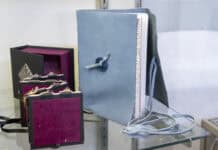In the city of Sedona’s process of providing sewer to nearly 50 percent of the city, not everyone who has gotten it has wanted it.
According to Interim City Manager Alison Zelms, people in areas that have received sewer have been in favor or against it 60/40 or 40/60 percent.
There’s never been 100 percent consensus, she said.
After receiving approval of a $10 million contract this summer, Tiffany Construction began installing sewer pipes to the Chapel area Aug. 4.
After some public outcry against sewer installation, Sedona City Council will consider possible qualifications Chapel residents could meet to defer connecting to the city’s sewer on Wednesday, Feb. 11.
Chapel resident Wendy Ferguson, co-owner of Contract Wastewater Operations, thinks cities, towns and even the nation should be responsible for connecting residents to municipal wastewater treatment plants and getting them off of individual on-site wastewater disposal systems like septic systems.
Fellow Chapel resident Cole Greenberg has been running on a septic system for 17 years and sees no reason to make the costly switch to the city’s sewer since his costs for septic have been minimal.
Becky O’Banion, who rents out her home in the Chapel area, can see both sides of the coin.
O’Banion bought a 1976 home in the Chapel area that she considered to be in great shape a few years ago.
During the pre-sale inspection, inspectors lifted the lid of the septic tank and the whole thing collapsed.
“The seller had no idea how it was,” O’Banion said. “She wasn’t trying to hide anything,” which makes her wonder how positive other Chapel residents can be that their septic systems are working fine.
The previous owner had to tear up the yard and replace the septic tank before the sale was final.
Following life’s twists and turns, O’Banion moved to Clarkdale instead, but began renting out her Chapel home shortly after the new septic was put in.
One day she received a call that the master shower was clogging. After a closer inspection, it was determined the pipes connecting her house to the septic tank had collapsed — something no one could have caught during the pre-sale inspection.
O’Banion spent $2,000 to replace the pipes, which the contractor packed with salt so roots from her large trees wouldn’t invade them again.
Now she worries that the wonderful trees that endear residents to the Chapel area will continue to damage septic pipes with their roots.
With such small lots in the Chapel area, close together, each with their own septic tank and leach field, O’Banion can see the benefits of connecting to city sewer, but she’s not in a position to pay for it.
Costs vary depending on length of yard, slope and type of soil, but lateral connections run between $1,000 and $5,000. Homeowners must also pay to fill in their septic tanks and pay a capacity fee of $5,150 this fiscal year. After they connect, residents receive a $32.54 monthly sewer bill or $29.52 for low-flow fixtures.
Wastewater Treatment Plant
Sedona’s Wastewater Treatment Plant was built in 1992 with a design capacity of 1 million gallons a day.
Since then, the plant has undergone upgrades to be able to take in 2 million gallons daily, Director of Public Works Charles Mosley said.
After going through four phases of treatment, the plant disposes the effluent through wetlands and spray irrigation on both sides of Highway 89A.
Although the plant can take in 2 million gallons a day, according to Director of Wastewater Division Pat Livingstone, the plant doesn’t have capacity to irrigate 2 million gallons a day.
“Our plant could treat it but it wouldn’t have any place to discharge it,” she said.
Currently the plant takes in 1 to 1.2 million gallons a day and tries to put out as much as it takes in daily, Chief
Plant Operator Brett Twardy said.
The plant discharges nearly 40 million gallons of effluent to the wetlands and marshes per year and irrigates nearly 300 million gallons a year, Livingstone
said.
Effluent goes through four treatment phases at the plant before being discharged to a holding pump where it is sucked to the wetlands or sprayed for irrigation.




















